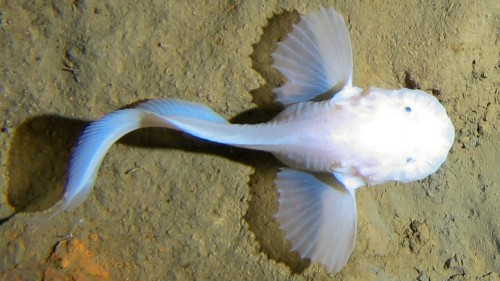uncharismatic-fauna:Swimming with the Mariana SnailfishesThe Mariana Snailfish (Pseudoliparis swirei
uncharismatic-fauna:Swimming with the Mariana SnailfishesThe Mariana Snailfish (Pseudoliparis swirei) Is one of the deepest-living fishes in the world. It is native to the Mariana Trench in the Pacific Ocean, and is found at depths of 6,000 to 8,000 meters. At that point, the pressure is almost 600 atm, or the equivalent of 1,600 elephants per square inch. Beyond this point, certain proteins begin to break down and bones can be crushed. However, the Mariana Snailfish has several adaptations that allow it to survive, and even thrive, at such pressures. For starters, P. swirei’s skeleton is not completely ossified. This means that their bones are not fully calcified, but consist mainly of cartilage, which gives snailfishes some flexibility. There are also gaps in its skull to stabilize the pressure. Furthermore, to prevent proteins in its body from breaking down, the Mariana Snailfish has a special chemical called trimethylamine N-oxide which stabilizes proteins. Most animals have one gene to produce this compound; Mariana Snailfishes have five genes. Because of this, they can also produce larger amounts of proteins to counteract the effect of pressure on the ability to move chemicals from one cell to another. Finally, like many other deep-sea organisms, these fishes lack functioning eyes and almost completely lack pigment. Although it’s small, at anywhere from 6 inches to just under a foot, the Mariana Snailfish is also the top predator of the Mariana Trench. They feed primarily on crustaceans and arthropods along the ocean floor, although they are also known to consume carrion or small fish when given the opportunity. Their eggs are similarly proportioned, with diameters of up to a third of an inch, in large clutches of almost 900. Out of all of these, only a handful are typically mature, and it is unknown if Mariana Snailfish provide parental care or what juvenile growth is like. In fact, very little else is known about the Mariana Snailfish, due to its size and the extreme inaccessibility to its habitat.Conservation Status: Unrated by the ICUN, due to lack of data. It is unlikely that the Mariana Snailfish is threatened. -- source link
Tumblr Blog : uncharismatic-fauna.tumblr.com
#reblog#mariana snailfish#pseudoliparis swirei#liparidae#snailfish#scorpaeniformes#actinopterygii#hadal zone#deep sea#mariana trench


